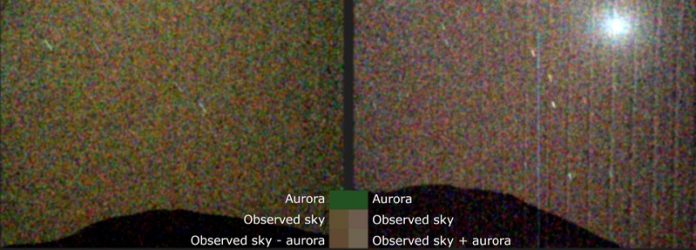
On March 15, 2024, NASA’s Perseverance rover made history by capturing the first-ever images of visible-light auroras on Mars.
This breakthrough happened during a powerful solar storm when the Sun unleashed a coronal mass ejection (CME), sending massive amounts of charged particles across the solar system.
These energetic particles interacted with Mars’ atmosphere, creating stunning auroras that lit up the Martian sky. Until now, such auroras had only been observed in ultraviolet light from orbit. This marks the first time they have been seen in visible light from the surface of another planet.
Unlike Earth, Mars does not have a strong global magnetic field to guide charged particles toward its poles.
Instead, Mars experiences a unique type of aurora known as a solar energetic particle (SEP) aurora.
Discovered by NASA’s MAVEN mission in 2014, SEP auroras happen when highly energetic solar particles strike the Martian atmosphere, causing it to glow across the entire night sky. These auroras are not limited to the poles and can appear anywhere on Mars.
To capture this rare event, a team led by Elise Knutsen, a postdoctoral researcher at the University of Oslo, carefully coordinated Perseverance’s SuperCam spectrometer and Mastcam-Z camera.
They modeled the best angles and perfect timing to catch the auroras during the peak of the Sun’s current solar cycle. Real-time analysis of the solar storm by NASA’s Moon to Mars Space Weather Analysis Office and the Community Coordinated Modeling Center (CCMC) helped them identify the perfect CME, which was powerful enough to inject many charged particles into Mars’ atmosphere.
When the CME reached Mars, Perseverance successfully captured images of a glowing green aurora stretching uniformly across the Martian sky.
The light emitted at a wavelength of 557.7 nanometers is the same green light seen in Earth’s auroras, caused by excited oxygen atoms in the atmosphere. To confirm the presence of SEPs during the aurora, the team cross-checked data from MAVEN’s SEP instrument and the European Space Agency’s Mars Express mission, which both verified the observation.
The discovery of visible-light auroras on Mars opens up exciting possibilities for future astronauts. Not only will they be able to witness this breathtaking phenomenon from the surface, but scientists will also gain new insights into how solar activity interacts with Mars’ atmosphere.
According to Shannon Curry, MAVEN’s principal investigator, this achievement was a perfect example of teamwork across multiple missions. Katie Stack Morgan, acting project scientist for Perseverance, added that understanding these auroras is crucial as NASA prepares for human exploration on Mars.
With this historic sighting, Mars continues to surprise us, revealing its hidden beauty and the promise of new adventures for those who will one day walk its surface.
Source: NASA.



